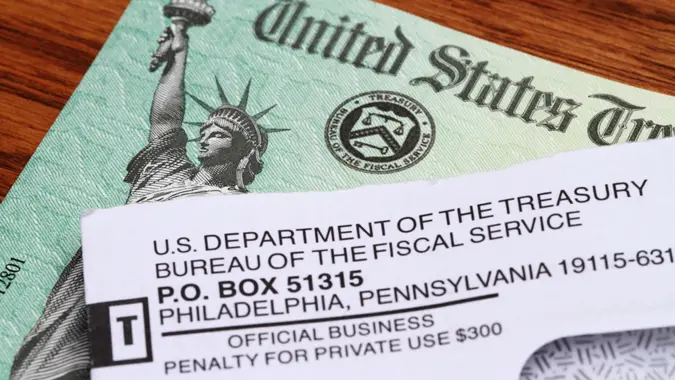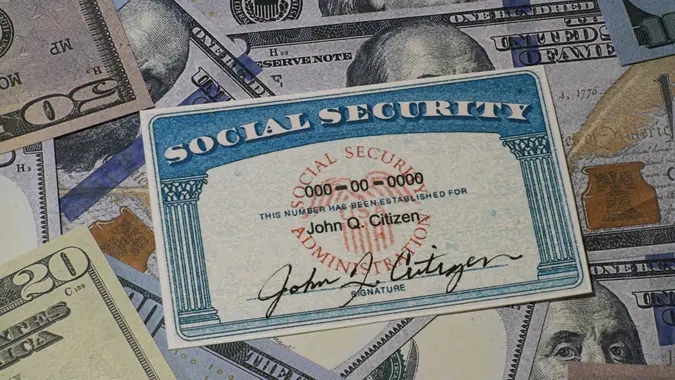Most Wouldn’t Survive If There Are Social Security Cuts — 6 Ways To Make Sure You Do

Commitment to Our Readers
GOBankingRates' editorial team is committed to bringing you unbiased reviews and information. We use data-driven methodologies to evaluate financial products and services - our reviews and ratings are not influenced by advertisers. You can read more about our editorial guidelines and our products and services review methodology.

20 Years
Helping You Live Richer

Reviewed
by Experts

Trusted by
Millions of Readers
Roughly half of adults 65 or older rely on Social Security benefits for at least 50% of their income, according to the Social Security Administration (SSA). About 25% of these adults rely on it for over 90% of their income.
But many Americans worry about the future of these benefits. The Medicare Rights Center expressed concerns after the Donald Trump Administration cut funding and closed SSA field offices earlier this year, and that says nothing of the looming insolvency acknowledged even by the House of Representatives.
So what should you do, as an American either planning for retirement or living it?
Max Out Tax-Advantaged Accounts
At the risk of stating the obvious, the more money you save while working, the less you’ll rely on Social Security benefits in retirement. And the less money you lose to taxes, the more you can set aside in your nest egg.
Start simple with opening and funding an IRA, and maxing out any matching contributions offered by your employer for a workplace retirement account. Traditional retirement accounts give you an immediate tax deduction, but you’ll pay taxes on withdrawals in retirement. Roth accounts let you prepay taxes now, but your investments compound tax-free and you pay no taxes in retirement.
From there, you can add more complexity if you want.
“Tax experts can help with strategies from layering brokerage accounts and real estate investments to Roth conversions to setting up S-corporations,” explains Dr. Pellumb Kabashi, founder of Tax Expert Today.
Buy an Annuity
You can replace Social Security with an annuity that pays you every month. Financial planner Evan Potash of TIAA points out that unlike Social Security, annuities let you customize exactly what you want.
“You can create an annuity that directly includes a spouse, who can collect the same benefit or a percentage of it,” Potash said. “Some annuities include a guaranteed period of payments or a refund. If both individuals pass away prematurely, the remaining payments go to the beneficiary.”
Explore Flexible Work in Retirement
Whether you still work full-time or have retired, consider doing fun, flexible, low-stress work in retirement.
“Working part-time or seasonally helps lift your retirement savings and reduce reliance on Social Security,” explained Melanie Musson, personal finance expert with Quote.com.
It can also help you postpone taking Social Security benefits, which can boost your benefit even if the government cuts benefits across the board.
Research the Right Medicare Advantage Plan
You have unique healthcare needs, so some Medicare Advantage plans can serve you better than others.
“People who comparison shop for Medicare Advantage plans can save over $1,800 a year,” notes Whitney Stidom at eHealth. “Take advantage of the fall Annual Enrollment Period (Oct. 15 to Dec. 7) to get the full range of options.”
Optimize Your Taxes in Retirement
Tax strategies don’t end when you retire. You can always trim your tax bill further.
“Develop a withdrawal strategy that minimizes taxable income,” adds Dr. Kabashi. “That includes optimizing when you draw from which accounts, tax loss harvesting, even charitable distributions.”
Speak with a professional to create a tax strategy based on your personal needs.
Move Somewhere Cheaper in Retirement
You aren’t chained to your current home, city, state, or even country. Consider downsizing to a new home, or moving to another city entirely.
Explore these cities where you can retire on $2,000 a month to get you started.
 Written by
Written by  Edited by
Edited by 


























